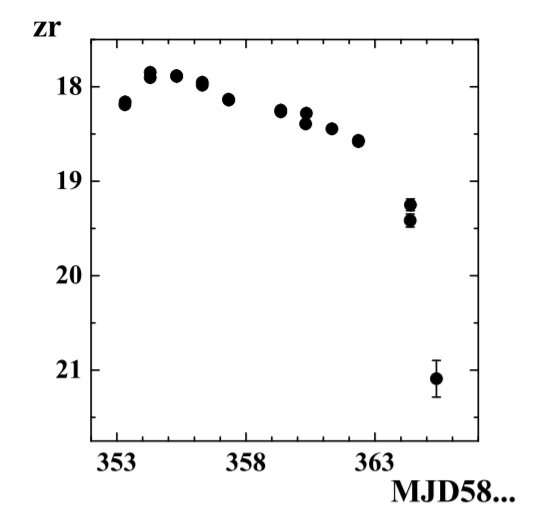March 10, 2021 report
A new dwarf nova: ZTF18abdlzhd is an SU UMa-type star, study finds

Using the Zwicky Transient Facility (ZTF) and the Caucasus Mountain Observatory (CMO), Russian astronomers have investigated a peculiar source designated ZTF18abdlzhd. The observations revealed that this object is an SU UMa-type dwarf nova. The finding is reported in a paper published March 4 on the arXiv pre-print server.
Cataclysmic variables (CVs) are binary star systems consisting of a white dwarf primary accreting matter from a normal star companion. They irregularly increase in brightness by a large factor, then drop back down to a quiescent state. These binaries have been found in many environments, such as the center of the Milky Way galaxy, the solar neighborhood, and within open and globular clusters.
Some CVs, which experience recurrent outbursts of 2-10 magnitude caused by accretion disk instabilities, are called dwarf novae (DNe). One subclass of these novae, known as SU UMa-type DNe (or UGSU), showcases long-lasting, brighter outbursts (superoutbursts) in addition to normal bursting activity.
ZTF18abdlzhd is a dwarf nova reported in the Zwicky Transient Facility Data Release 3. A team of astronomers led by Sergei V. Antipin of the Lomonosov Moscow State University (MSU), Russia, conducted a CCD photometry of bursting activity of this source using CMO in order to shed more light on its properties.
"CCD photometry of ZTF18abdlzhd carried out in August and October 2020 permit us to follow the end of the fading stage of one outburst and a full superoutburst of this dwarf nova," the researchers wrote in the paper.
According to the study, ZTF18abdlzhd started to increase in brightness on October 10, 2020. It reached the maximum brightness of 17.49 mag on the next day and faded to 21.8 mag 12 days later. Afterward, the dwarf nova passed beyond the detection limit (about 22.0 mag); therefore, its variability amplitude turned out to be greater than 4.5 mag.
Furthermore, the researchers detected periodic brightness variability during the maximum of the superoutburst. These phenomena known as superhumps—photometric modulations in the light curve with periods slightly different from the orbital period. Superhumps are present in SU UMa-type DNe during superoutburst and in the case of ZTF18abdlzhd, the period of this variability was measured to be approximately 0.07 days.
Although the photometric data covered also one more outburst of ZTF18abdlzhd, which occurred in August 2020, the astronomers had no opportunity to classify the type of this event because the observations reveal only its final stage. Thus, whether or not the August event is a superoutburst remains uncertain.
Summing up the results, the researchers concluded that all the obtained data confirm the SU UMa-type DN nature of ZTF18abdlzhd.
"Based on the ZTF survey data, we suspected that object ZTF18abdlzhd is a UGSU-type star. Our CCD observations allow us to confirm this assumption," the authors of the paper wrote.
More information: New SU UMa-type star ZTF18abdlzhd in the Zwicky Transient Facility data, arXiv:2103.03042 [astro-ph.SR] arxiv.org/abs/2103.03042
© 2021 Science X Network




















